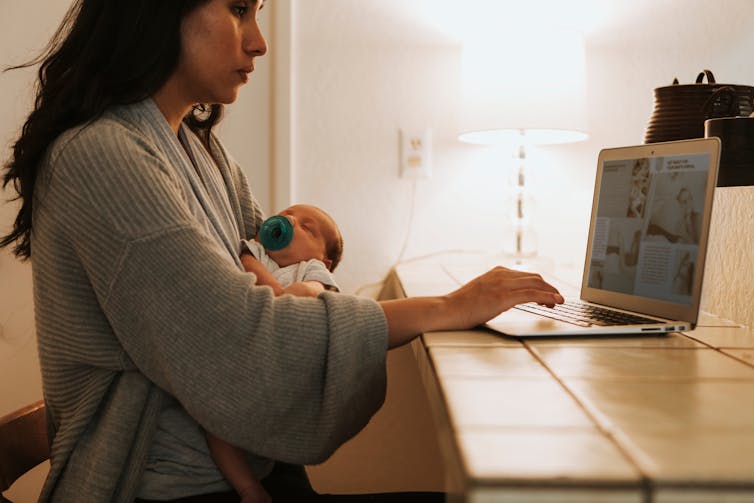Canada is facing a critical shortage of caregivers, both paid and unpaid. And those who do this vital work face significant pressures that are impacting their lives. In particular, there are high costs to immigrant women for taking time off of paid work to care for their own babies.
Immigrant women disproportionately work caring for children, elderly adults and people living with disabilities. At the same time, immigrant care workers earn low incomes and experience precarious employment. The fact that these women experience further economic penalties for taking maternity or parental leave is a pressing social issue.
My recent paper in Canadian Public Policy documents for the first time the financial implications immigrant women face for taking time out of the labour market to care for a child. I use Statistics Canada data from the Longitudinal Immigration Database (IMDB) and the 2018 General Social Survey (GSS).
The data revealed a gendered, classed and racialized divide among women caring for their children in Canada today. It’s a divide that is having a negative financial impact on immigrant women doing this work.
Disparities in who is caring for children
The data revealed patterns of who is providing unpaid care for children. Women were more than eight times as likely as men to be caring for children or on parental leave.
Immigrants were 1.8 times as likely to report these as their main activities compared with non-immigrants. Racialized populations were 1.5 times more likely than non-racialized populations to be providing this care.
Further, my analysis finds that immigrant women who came to Canada via the Live-in Caregiver/Caregiver Program (LCP/CP) had a substantively higher probability of having a birth-related career interruption than comparable immigrant women who entered Canada via the family or economic immigration programs.
Data suggests that, in the vast majority of cases, income will be lower the year after a birth-related career interruption. (Shutterstock)
Financial disadvantages for providing essential unpaid care
I looked at immigrant women who took time out of the labour market to care for their babies and compared their income the year before the career interruption with the year after.
I found that the probability of having income ten per cent lower the year after a birth-related career interruption is highest for women who immigrated through the family class program, followed closely by those in the caregiver program and those who immigrated through the economic class.
The differences were small. Instead, there is a large divide across scenarios rather than entry classes. Notably, all immigrant women have much lower probabilities of having either the same or higher income after a birth-related career interruption.
This suggests that for immigrant women in Canada, in the vast majority of cases, income will be lower the year after a birth-related career interruption than prior. There are financial penalties for caring for their own children.
What can the federal government do?
Most important legislation affecting the career earnings trajectories of immigrants operates at the provincial level. For example, policies tied to collective bargaining and unionization, education and training, minimum wage, employment standards and occupational health and safety are set by provincial governments.
These are of critical importance to immigrant women workers, but there is wide variation across Canada.
At the federal level, however, concrete changes to the caregiver program and to Employment Insurance (EI) could help to address the challenges highlighted above. The four changes proposed below would be important steps forward for immigrant women care workers.
Changes to caregiver programs and to Employment Insurance could help to address the challenges caregivers face. (Shutterstock)
First, immigrants who enter Canada via caregiver programs should be eligible to access maternity leave and workers compensation benefits regardless of whether their status in Canada is temporary or permanent. As well, encouraging better education regarding maternity and parental leave entitlements so immigrants know their rights might improve take-up rates.
Second, the government should increase and improve programs to support the labour market integration of immigrants coming to Canada via caregiver programs. This would include assisting with transfer and recognition of foreign credentials which has been widely identified as an area in need of support. This would also help immigrant care workers find work that is commensurate with their training and skills, likely with higher pay and better maternity benefits.
Third, further increasing federal funding for paid child-care provision would assist in alleviating the shortage of workers. Improving the quality, accessibility and affordability of paid child care would assist immigrant women in transitioning back to the labour market after having a baby. It would also improve pay for child-care workers, who are disproportionately immigrant and racialized women.
Fourth, governments need to look at reforming EI and other related programs through a gender-based analysis. This could include implementing new or more tax credits for unpaid caregiving, increasing flexibility in the definition of allowable expenses, changes to the child benefits system, increasing short-term programs to address deskilling from extended time outside of the labour market caring for children, and suggesting regulatory changes to the definition of self-employment for income tax purposes.
These changes would better ensure that career interruptions tied to childbirth and care do not unduly impact or disadvantage immigrant women over their working lives. The minimum we can and should do as a society is ensure that immigrant women who devote their working lives to caring for others are equally cared for themselves when they become mothers.



 Can your cat recognise you by scent? New study shows it’s likely
Can your cat recognise you by scent? New study shows it’s likely  Youth are charting new freshwater futures by learning from the water on the water
Youth are charting new freshwater futures by learning from the water on the water  Ethereum Bulls Reload: $175M ETF Inflows + Super-Whale Grabs $54M ETH as Price Coils for the Next Big Move
Ethereum Bulls Reload: $175M ETF Inflows + Super-Whale Grabs $54M ETH as Price Coils for the Next Big Move  EUR/USD Smashes 1.1660 as ADP Jobs Massacre Crushes the Dollar
EUR/USD Smashes 1.1660 as ADP Jobs Massacre Crushes the Dollar  What’s the difference between baking powder and baking soda? It’s subtle, but significant
What’s the difference between baking powder and baking soda? It’s subtle, but significant  Debate over H-1B visas shines spotlight on US tech worker shortages
Debate over H-1B visas shines spotlight on US tech worker shortages  Why have so few atrocities ever been recognised as genocide?
Why have so few atrocities ever been recognised as genocide?  The pandemic is still disrupting young people’s careers
The pandemic is still disrupting young people’s careers  The Beauty Beneath the Expressway: A Journey from Self to Service
The Beauty Beneath the Expressway: A Journey from Self to Service  Why a ‘rip-off’ degree might be worth the money after all – research study
Why a ‘rip-off’ degree might be worth the money after all – research study 































